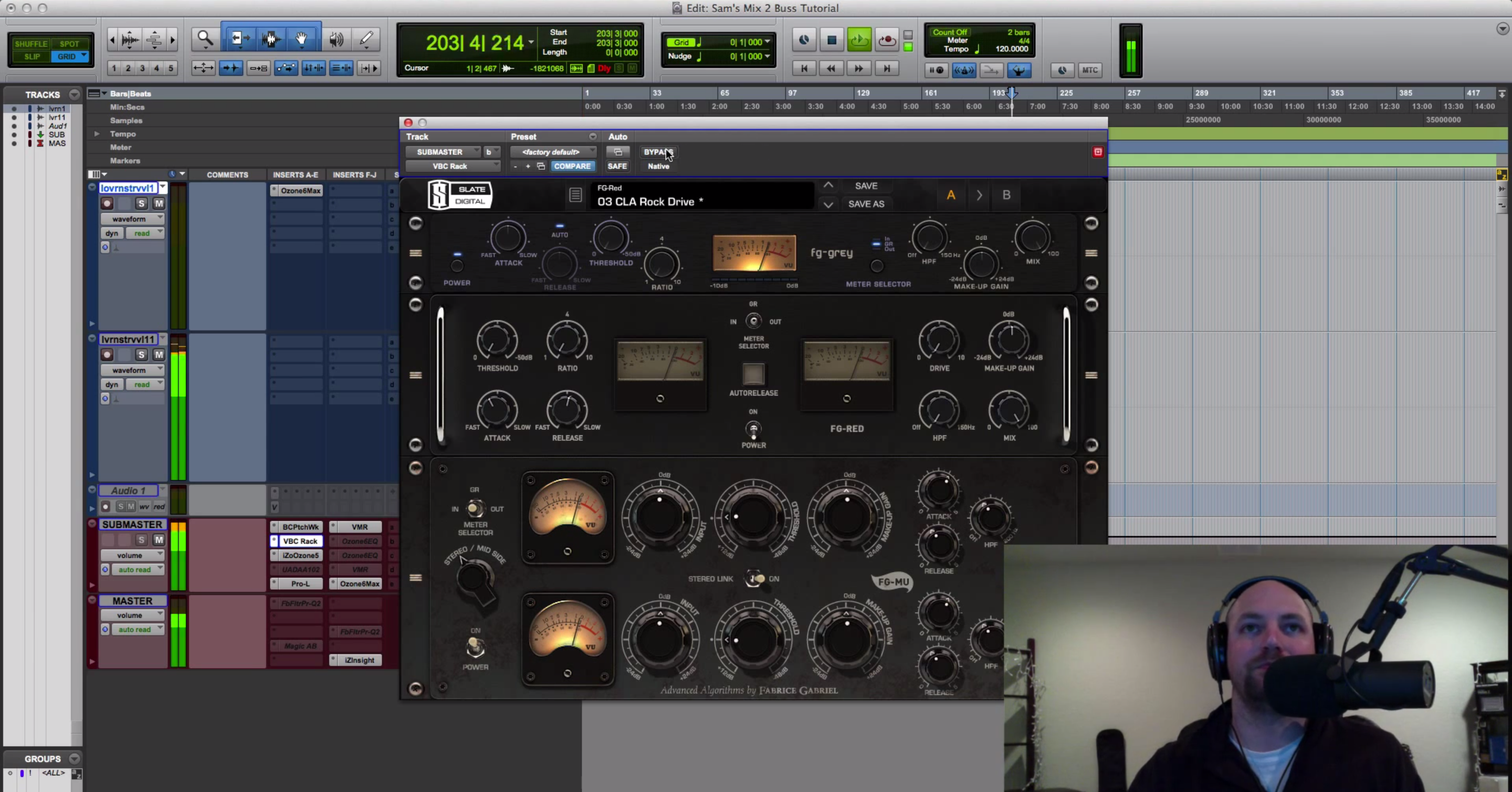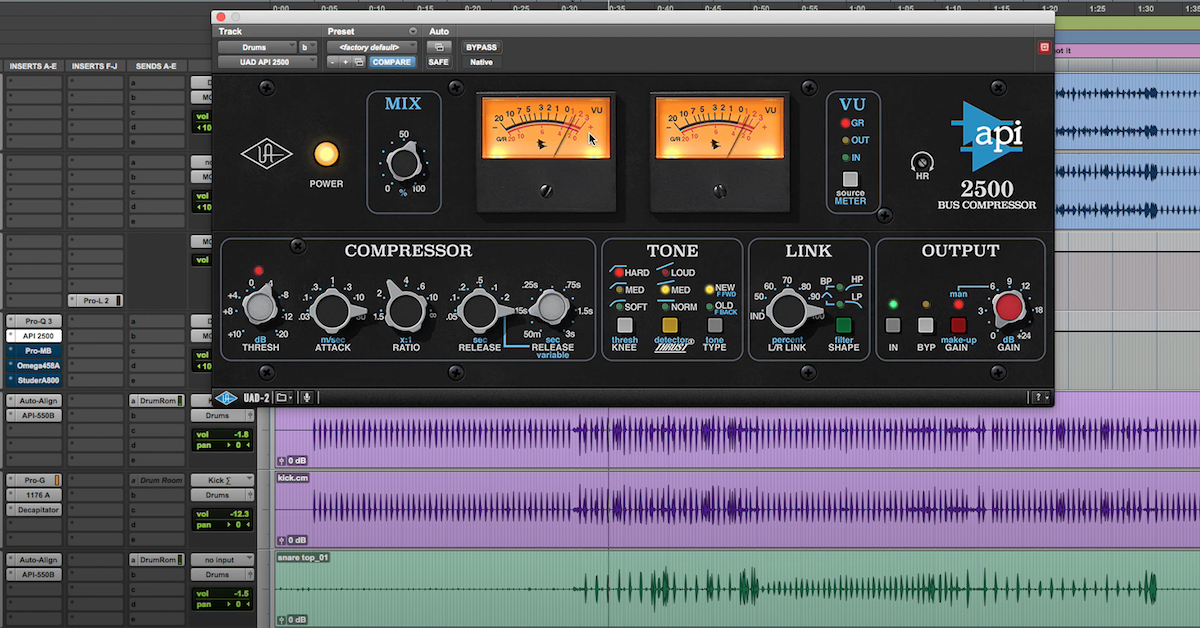Tips for Processing the Stereo Buss Without Compromising the Mix
Recently, I wrote an article on five plug-ins that you could use to boost perceived loudness, and there were some really great comments suggesting that I show you how I use them, giving practical examples, rather than just listing them.
So that’s what I’m going to do right now. Just for the sake of ease, I’m going to be mastering just within Pro Tools using plug-ins, okay?
Let’s take a listen to this track, which is Coat of Love, by the band Sunny Love and the Moon Parade. Pre-mastered before any effects.
[music]
Alright. Now, let’s take a listen post all of my effects.
[song plays, louder]
Alright. Somewhat louder. A little bit brighter. Definitely close to modern standard mastering specifications. Okay? So let me show you how I got there. I like starting with this brainworx plug-in. It’s a mid/side EQ, which allows me to carve out space for the vocals, the guitars – it allows me to treat things that are in the center separately than the stereo section.
I’m going to hit play and show you an example of how I use it.
[music, filtered]
When you select a frequency, it solos that band.
[music continues playing, filtered]
Which essentially allows you to find problem frequencies. Things that ring out, things that are not sympathetic with the music. Okay?
Let’s listen to a couple more that I chose to attenuate.
[music plays, changing filters]
Okay, so that is the mono section, which generally, we’re only going to be treating the things that are in the center, like the bass, vocals, kick drum, and snare drum.
Let’s listen to the stereo section.
[song plays, listening to side channels filtered]
So I like to use an attenuating EQ before any compression, because I don’t want to overload any compressors that might be following.
One that was on my list in terms of helping with perceived loudness is the Universal Audio Neve 33609. Let’s restore the factory default, and I’ll show you how I would use this.
[mix playback]
As you can see on the meter, we are approaching 4 dB and we have a relatively slow recovery. For mastering, we don’t want that much gain reduction, and we want a faster release, so what I’m going to do is engage the limiter, make the recovery time on the limiter and the compressor as fast as possible, and turn up the threshold – I’m going to hit play and turn up the threshold until I only have about 1-2 dB of compression.
[mix playback]
I’m much more comfortable with that. If I turn up the ratio, you will hear much more compression.
[mix playback]
So generally, I’m pretty happy with a mastering compressor that only has – only offers about 1-2 dB of compression and limiting. Okay?
Next on my list was this L3 multi-maximizer. The reason I like it is because it allows you to target specific frequencies to compress. Let’s hit play.
[mix]
So, for example, the low-mids here might be a little bit muddy, and contributing to some frequency buildup.
Perhaps there’s some harshness in the 2-4kHz range? And I can attenuate subtly. This is a little bit less subtle than I would like. Let’s bring the threshold up a little bit.
[mix]
For this particular mix, this plug-in did not make the final master.
Next, this was also on my list, was the Universal Audio ATR-102 from Ampex. This plug-in really adds a lot of vibe, color, and character, while boosting volume just a little bit.
[mix plays]
Speaking of glue, we’ve got The Glue from Cytomic. This is an emulator of the SSL master buss compressor.
I really like this feature where you can turn the wet/dry balance to wherever you desire. Basically emulating parallel compression, because I find if you have the wetness all the way up, it introduces some high end that I don’t always like, so I tend to keep it pretty low. Generally under 50%.
With compressors on your master fader, it’s extremely important to know your attack and release times. I like having slow attack and fast release times to allow the transients to come through, and introduce just a little bit of excitement to the mix with a fast release.
Let’s listen to it.
[song]
Way too much.
[song continues playing]
Once again, only about 2dB of compression at the most there.
Next, we have a Pultec emulation from Universal Audio. It does a great job of increasing perceived loudness by adding high end. Remember, if you add high end to something, it is perceived as louder, so we are adding about 4dB at 16kHz, which opens things up a little bit.
[song plays]
Makes things a little bit brighter and more hi-fi.
Next, another multi-band limiter. This one is from FabFilter. It does a great job of attenuating problem frequencies.
[song plays]
I can solo the band.
[song plays, filtered]
So, you can hear that is a pretty harsh range right there, so I’m attenuating just a little bit. At most, 2dB, only within this range here.
Same thing down here.
[song plays, filtered]
A lot of low frequency buildup there.
[song plays]
One of my favorite limiters, the L2007 mastering limiter from Massey.
[song plays]
It can get intense pretty quickly, as most plug-ins can, but always just keep an eye on the meters. You only want to be reducing a couple of dB of gain at the most, if at all. Okay?
This is another limiter from PSP. The Xenon. It’s basically doing the same thing as the Massey. The reason that I’m using multiple limiters in serial is because I would rather have them share the load of gain reduction, instead of overworking any one plug-in. If they can work together on them, generally, I find that it’s a more transparent sound.
[song plays]
There are some great features on this limiter, including transient predict, so it allows your kick and snare to cut through, variable release time, and a lot of great metering.
Lastly, something that I can’t live without now is the Pro-L from FabFilter.
[mix plays]
So, this line right here is a readout of the RMS value of what is being fed into this limiter. It is important as a mix and mastering engineer to be competitive with things that are coming out every day, but also be realistic and try not to add distortion and pumping and too much compression to your mixes.
So, having this readout is extremely valuable, and I like to keep a balance between the gain. These features right here, once again you have attack, release – I generally like slow attacks and somewhat fast release – and there are these four different styles that actually do sound very different, you just have to really pay attention. They’re subtle, but they definitely make a huge difference. Okay? I also, rather than an L2, which can only go in 0.1 dB increments, this can go in .01 dB increments. Okay? So that’s helpful in certain cases as well. Also, some great dithering and oversampling options here.






